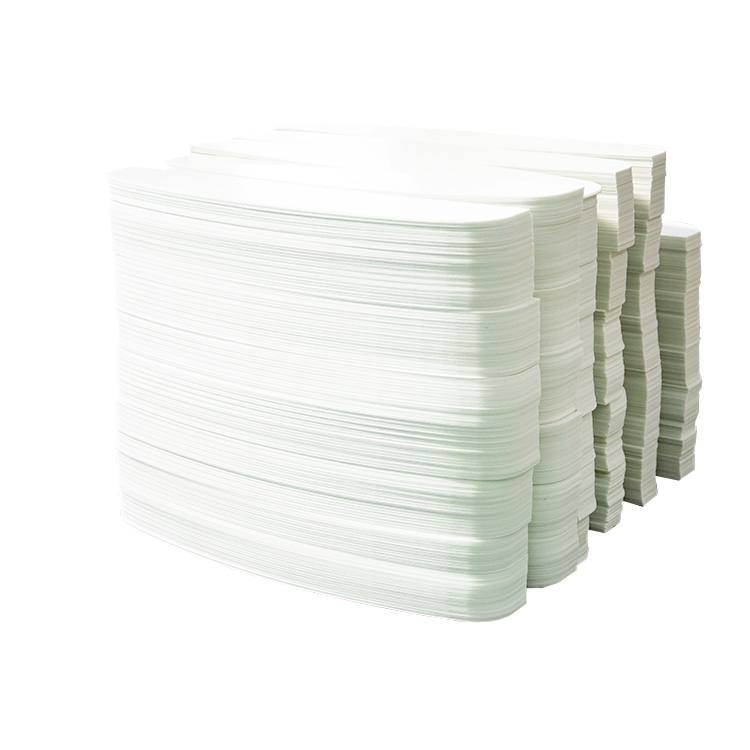Application of GMT in Automobiles
Automotive-grade GMT is typically a composite sheet made of two layers of glass fiber needle-punched felt and three layers of thermoplastic resin (like PP or PA)28. It has a density of approximately
1.1sim1.2g˜ /cm329. The material boasts high impact toughness, high specific strength, suitability for mold-pressing, and recyclability30. These qualities have led to its increasing use in passenger cars for components such as underbody shields, spare tire wells, tailgate modules, bumper beams, battery boxes, instrument panel skeletons, and front-end modules31.
The following sections compare two GMT materials produced via the fluidized bed process—one with 23% glass fiber (F23) and another with 30% (RD30)—against DC03 metal for an engine underbody shield32. The critical performance indicators for this part are stiffness and impact resistance33.
2.1 Material Performance Comparison
2.1.1 Basic Physical Properties
|
Material |
Density /g.cm⁻³ 34 |
Elastic Modulus /MPa 35 |
Poisson's Ratio 36 |
Material Thickness /mm 37 |
|
DC03 |
7.9 38 |
210,000 39 |
0.30 40 |
1.5 41 |
|
GMT(F23) |
1.1 42 |
3,500 43 |
0.33 44 |
2.5 45 |
|
GMT(RD30) |
1.1 46 |
4,000 47 |
0.35 48 |
2.5 49 |
2.1.2 Mechanical Properties
The following table summarizes the mechanical properties of the three materials under various conditions50.
|
Test Item |
DC03 51 |
F23 52 |
RD30 53 |
|
Density /g·cm⁻³ |
7.80 54 |
1.07 55 |
1.13 56 |
|
Tensile Strength /MPa |
270 57 |
45.0 (Normal) |
93.4 (Normal) |
|
Elongation at Break % |
34 60 |
2.82 (Normal) |
3.02 (Normal) |
|
Bending Strength /MPa |
270 63 |
65.8 (Normal) |
105.5 (Normal) |
|
Bending Modulus /MPa |
205,000 66 |
3,782.8 (Normal) |
5,033.8 (Normal) |
|
Cantilever Beam Notched Impact Strength /kJ·m⁻² |
|
32.54 (Partial Failure) |
39.45 (Partial Failure) |
|
Water Absorption /% |
|
0.04 71 |
0.04 72 |
|
Heat Deflection Temperature (0.45 MPa) /°C |
|
162.0 73 |
166.7 74 |
|
Ash Content (by burning) /% |
|
24.4 75 |
29.8 76 |
Aging condition: 70°C, 95% R.H., 72h 77
Low-temperature impact: -30°C, 10 min 78
2.1.3 Analysis of Mechanical Properties
Normal Conditions: The RD30 material (higher glass fiber content) showed superior mechanical properties compared to the F23 material (lower glass fiber content)79. Specifically, its tensile strength was 107% higher, bending strength was 60.3% higher, bending modulus was 33.1% higher, and cantilever beam notched impact strength was 21.2% higher80.
Aging Performance: Wet heat aging had a minimal effect on the mechanical properties of the GMT materials81. The materials also demonstrated good resistance to low-temperature impact82.
Heat Deflection and Water Absorption: The RD30 material had a higher heat deflection temperature than F2383. Both GMT variants exhibited very low water absorption, which explains why their mechanical properties are not significantly affected by wet heat aging84.
2.2 Engine Underbody Shield: Structural Design and Optimization
To compensate for the lower elastic modulus of GMT compared to steel, the GMT part thickness was increased to 2.5 mm from the 1.5 mm steel plate85. The design was also structurally optimized by reducing weight-saving holes and adding reinforcing ribs and bent edges to ensure stiffness86.
2.2.1 CAE Modal Analysis
A modal analysis was conducted on the DC03 shield, as well as the pre-optimization and post-optimization GMT shields87.
|
Mode Order |
DC03 Shield (Hz) 88 |
GMT Pre-Opt. RD30 (Hz) 89 |
GMT Post-Opt. RD30 (Hz) 90 |
GMT Post-Opt. F23 (Hz) 91 |
|
1 |
35.2 92 |
34.4 93 |
34.6 94 |
34.2 95 |
|
2 |
48.5 96 |
36.2 97 |
40.3 98 |
37.8 99 |
|
3 |
47.6 100 |
40.4 101 |
52.6 102 |
44.5 103 |
The modal frequency of the GMT shield improved significantly after optimization104. The RD30 material with higher glass fiber content performed better than the F23 material105.
2.2.2 CAE Impact Strength Simulation
An impact strength analysis was simulated using a 3.5g acceleration to represent extreme conditions106. The results showed that the maximum stress in the DC03 shield was 65 MPa107. The maximum stress in the pre- and post-optimization GMT shields was 5.0 MPa and 5.6 MPa, respectively108. All three designs met the impact strength requirement for a 3.5g acceleration109.
2.3 Verification of Key Performance Indicators
Bench tests were performed to validate if the sample parts met the design requirements for stiffness and impact strength110.
|
Test Item |
Test Method and Requirement 111 |
Test Result 112 |
|
|
|
Stiffness |
Method: At room temperature, the shield was fixed in its vehicle assembly state. A 150N load was applied by a 30mm diameter presser head at a weak point, with the head moving at 5 mm/min. |
Requirement: Maximum deformation < 15 mm. 113 |
|
DC03: 11.7 mm |
|
Impact Strength |
Method: Normal Temp: At 23°C, a 2000g steel drop hammer was released from a height of 50 cm. Low Temp: At -30°C, an 800g steel drop hammer was released from a height of 50 cm. |
Requirement: No abnormalities in the sample. 115 |
No abnormalities observed for any sample116. |
|
The bench tests confirmed that the GMT underbody shields meet the critical performance requirements for stiffness and impact strength117. Full-vehicle durability testing also confirmed they met design requirements118.
3. Conclusion
The optimized GMT engine underbody shield weighs only 1.14 kg, achieving a 65.5% weight reduction for the single part compared to the original steel version119. This also resulted in a cost reduction of approximately 22%120. The GMT part's stiffness and impact strength successfully met key design performance metrics, contributing to vehicle lightweighting121.
Furthermore, GMT offers superior stability, chemical resistance, and weather resistance compared to steel, eliminating the need for painting122. This simplifies the production process and reduces environmental pollution123. With continuous improvements in GMT manufacturing technology, its application is expected to expand widely in the automotive industry, particularly for pure electric vehicles where lightweighting is a critical goal124.




